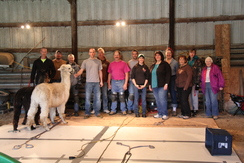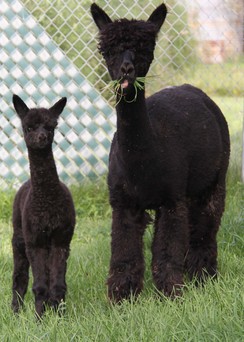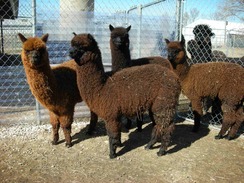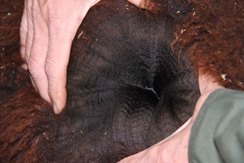|
|
Wednesday, September 6, 2017
When discussing lingering fleece qualities I would like us to focus on AFD and SD only but certainly could staple length or fleece weight. Recently I was challenged by a well known and experienced person why worry about lingering fleece qualities. The reasoning was due to keeping older genetics rather than cycling them out for more improved genetics. I am certain there are many more reasons but that was my take away. My answer was reduction in cost was the primary reason there is an appreciatio read more...
|
Tuesday, February 7, 2017

The 2015 crew!
We are shearing approximately 68 alpacas. We employ the Noodling method and work with a professional shearer Brent Winslow utilizing the two stage shearing method as well. This is the time to experience husbandry in one day with nail trimming, shearing, CD&T inoculations, and fleece assessments. Haltering and leading alpacas at its best. You are welcome to watch or help. We simply request if you would like to attend even if you stop by for only 20 minutes to let us know at least two weeks in read more...

Marge nail trimming

The Gals ready for shearing.

Marge giving shots while station one is shearing

The results.
|
Monday, September 14, 2015
Let's start with micron. Think of micron as a ruler. A ruler is divided into lengths 1/8, 1/4, 1/2, 3/4, 1 inch so you can measure different lengths. Micron is the measurement of thickness like you would measure the diameter of a circle. When applied to alpaca fiber it is the measure of the thickness of fiber but when reported it is the average thickness of many fibers in a sample. Relative to humans, most cannot distinguish variation under 3 micron with the eye or feel but generally can disting read more...
|
Monday, April 7, 2014
Wednesday’s weather prediction for Friday our travel day to the show, was rain, sleet, snow, freezing rain, and high winds – not the weather we look forward to hauling alpacas in a trailer. MAE emailed a notice Wednesday that they prepared the facility to accept alpacas Thursday for early arrival to avoid the weather. Marge was able to rearrange her schedule, as I scrambled to get the show supplies ready to go and we met somewhere in the middle when Marge called and said she could be home at 11a read more...
|
Monday, December 9, 2013
OK, for you that have automatic water'rs this is the time to put your feet up on the desk, sit back, and have a good laugh or reflection on why you water the way you do. Last night temperatures reached zero. I was finishing chores as the sun set and was interested in finishing soon because the temperature was dropping rapidly and I was beginning to feel the sting. So I wrapped up and did not do my usual checklist just before heading in and apparently thought I would do it when I started today read more...
|
Wednesday, November 20, 2013

Genetic gain passed to the young.
When quality females are offered as “production” or “foundation” this seems to trigger a Typhoid Mary response. What no banners? Selecting alpacas from show winners relies only on phenotype. You may say –no- they also have great pedigree!
If your goal is developing a quality line of alpacas that produce consistently higher quality alpacas these are the three weakest criteria when selecting foundation females, show placement, phenotype, and pedigree.
Let us share our experience to su read more...

The next generation.

Not every plan works - where's the black!????
|
Sunday, November 3, 2013

Osiceca in front of others from production females.
Dystocia defined in medical journals state, “abnormal labor or childbirth” or “a slow and difficult labor or delivery.” Dystocic births that result in a failed birth are costly in many respects. Potential need of a veterinary is a direct cost. Loss of 660 days of production and we arrive at this number due to waiting 2 years to see the next cria on the ground and the results of that breeding success toward genetic gain. We define success as not only a successful birth but the phenotypic gain read more...

K-RAN Karley production female.

Isabelle production female.

Wiyaka-reduced risk off farm breeding.

Heyun Sapa - Reduced risk on farm breeding.
|
Thursday, October 31, 2013
Marge and I entered three of our maidens in True Black Yearling Huacaya at the Illinois Alpaca Show in Grayslake October 26, 2013. We predicted the order if they did not walk was Suluta, BobbyJo, and Atungya. Suluta possesses the type of fleece the spinning mills seek where the primary and secondary fibers are nearly equal. BobbyJo has nice fleece with great conformation but shorter staple, and Atungya carries nice conformation but her primary fibers are a bit heavier than her secondary fiber read more...
|
Wednesday, October 23, 2013

Hanblecheyapi "buttery" Fleece.
We attended the Michigan Alpaca Festival in Grand Rapids Michigan October, 2013. The judge’s recitations included “finest in the class but lacks the density…”, “best fleece in the class but would like to see a larger frame – but they are young and have growing to do”, but always “extremely nice hand.”. We hear “extremely nice hand” in recitations consistently from one judge to the next.
In part “hand” is a result of uniformity measured by Standard Deviation in Watt (OFDA2000) or Yocom (OFDA read more...

Wasake contributes hand, consitency, fineness, density.
|